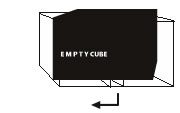JOSÉ VALENTE
APRIL, 4, 2014

CONTACTS
www.josevalente.com
EXHIBITION INFORMATION
SONATA FOR VIOLA AND EMPTY CUBE
Concert
Contribution: Manuel Brásio (manuelbrasio.webs.com)
Concert for Cube and viola
Musician José Valente engages the challenge of working in the visual arts field as if it were a duet, perhaps not exactly between himself and the visual arts, but at least between himself and Empty Cube, the object/location that manifests here in its full materiality, being used as a percussion instrument. The percussion, however, is performed from inside it, as if generated by the cube itself.
Having considered what the rules of this game presuppose, as well as the fact that things are expected to happen within the cube's space, the musician has opted to strategically place himself off the field.
This off-the-field condition, however, is also a space that is a double of the cube, or at least an echo of it.
And the black square on which José Valente stands has the same area as the cube, being the result of that object's projection on a horizontal plane. A projection that compacts all dimensions onto a single plane, an abstract place that takes the musician out of any place: the best way he found to position himself within this physical and conceptual context.
But, and certainly unbeknownst to him, this way of being off this field actually places him at its centre. Indeed, all of us are aware of how important black squares (or at least one of them) are in terms of art history.
In 1983, in Almada, I had the privilege of witnessing two memorable performances by a major player in the Fluxus movement (at one of the much-missed international performance art festivals organised by Egídio Álvaro).
In “Concerto for Poemophone”, Serge III Oldenbourg played a rudimentary single-stringed instrument. Monochordically (of course), he strummed that string in monotonous cadence, a monotony that was broken by his charming demeanour, which beamed out of his generous moustache and smile.
Serge III was probably unable to play any instrument, or, at least, was trying very hard, at that moment, to not give us any inkling he could do so. However, he monochordically managed to suggest all the music in the world, or, more precisely, to bring us into contact with the very materials of music, as if he were suggesting the possibility of a pre-musical era and bringing us to it.
But José Valente is indeed a musician; music being his chosen field, it is there that he finds the best means to engage with the visual arts, in the same way he tackles his Contemporary Arts PhD at the Coimbra University College of Arts: as a dialogue, inevitably.
There is yet a lot to discuss. We have not discussed music here. And what is missing is probably the most important thing. Even in its potential of change. As a bowed instrument, the viola will certainly soften the cube's sharp edges.
António Olaio
Coimbra, 8 March 2014






